A Hybrid Recommendation Approach for Viral Food Based on Online Reviews
Abstract
:1. Introduction and literature Review
1.1. Research on Recommendation Approaches
1.2. Sentiment Analysis Research
2. The Proposed Hybrid Recommendation Approach
2.1. The Technical Aspect of the Hybrid Recommendation Approach
2.2. Sentiment Analysis of Online Evaluations
2.2.1. Construction of a Custom Sentimental Dictionary Based on SO-PMI
2.2.2. Sentiment Value Calculation Based on Custom Dictionary
2.2.3. Accuracy Evaluation Index for the Sentiment Analysis
2.3. Hybrid Recommendation Approach Based on Sentiment Analysis
3. Recommendation Approach Application and Comparative Analysis
3.1. Data Collection and Preprocessing
3.2. The Application of the Hybrid Recommendation Approach
3.2.1. Sentiment Analysis Based on Users’ Reviews
3.2.2. Analysis of Hybrid Approach Results
3.3. Comparative Analysis of the Recommended Approaches
3.4. Empirical Study
4. Discussion and Conclusions
- (1)
- The sentiment tendency of the review text identified using the custom domain sentiment dictionary has high accuracy, and the evaluation index of the experimental results is high. Therefore, this method is conducive to text sentiment analysis, which is an important step of the personalized recommendation system.
- (2)
- The recommendation results of the hybrid approach vary with different parameters. It is found that, when the number of nearest neighbors, K, in the user-based collaborative filtering recommendation approach is 2, and the weight of the content-based recommendation approach is 0.9, the predictions are most accurate.
- (3)
- By comparing the MAE value and accuracy of the hybrid approach and the traditional approaches, it is found that the content-based recommendation and the hybrid recommendation approaches are better than the user-based collaborative filtering recommendation approach. Among the content-based recommendation and the hybrid recommendation approaches, the results of the hybrid recommendation approach are slightly better.
- (1)
- Improving the domain’s sentiment words: The more comprehensive the construction of the domain’s sentiment words, the more accurate the calculation of the sentiment values. In this paper, the use of about 10,000 reviews as the basic corpus has certain limitations. The words are not comprehensive enough, resulting in low dictionary performance and sentiment score calculation performance. Therefore, it is necessary to better construct the sentimental dictionary.
- (2)
- Improving user data information: User preference information is very important for calculating the similarity between users. It directly affects the results of the collaborative filtering recommendation approach. Owing to the protection mechanism of user privacy on the JD.com (accessed on 9 May 2021) platform, it is difficult to obtain user purchase and evaluation record data. Once the amount of review data obtained is large enough, the construction of user portraits can be more accurate.
- (3)
- Comparing the results of multiple hybrid recommendation approaches: Different hybrid methods can be used to combine multiple approaches, and the optimal recommendation approach can be improved by continuously adjusting parameters.
- (4)
- Validation of results from multiple aspects: Using MAE calculation and accuracy calculation methods to judge the performance of the prediction results is one-sided. The stability of the hybrid approach can be further judged based on different data sets using cross-validation methods. It would be a more comprehensive measure of the recommendation performance of the hybrid approach.
Author Contributions
Funding
Institutional Review Board Statement
Informed Consent Statement
Data Availability Statement
Acknowledgments
Conflicts of Interest
References
- Akyazi, T.; Goti Elordi, A.; Oyarbide Zubillaga, A.; Alberdi Celaya, E. A guide for the food industry to meet the future skills requirements emerging with industry 4.0. Foods 2020, 9, 492. [Google Scholar] [CrossRef] [PubMed] [Green Version]
- Cranfield, J. Framing consumer food demand responses in a viral pandemic. Can. J. Agric. Econ. Rev. Can. D Agroecon. 2020, 68, 151–156. [Google Scholar] [CrossRef]
- Galanakis, C.M.; Rizou, M.; Aldawoud, T.M.S.; Ucak, L.; Rowan, N.J. Innovations and technology disruptions in the food sector within the covid-19 pandemic and post-lockdown era. Trends Food Sci. Technol. 2021, 110, 193–200. [Google Scholar] [CrossRef]
- Lekakos, G.; Caravelas, P. A hybrid approach for movie recommendation. Multimed Tools Appl. 2008, 36, 55–70. [Google Scholar] [CrossRef]
- Anand, D.; Bharadwaj, K.K. Utilizing Various Sparsity Measures for Enhancing Accuracy of Collaborative Recommender Systems Based on Local and Global Similarities. Expert Syst. Appl. 2011, 38, 5101–5109. [Google Scholar] [CrossRef]
- Kim, T.H.; Yang, S.B. An Effective Threshold-Based Neighbor Selection in Collaborative Filtering. In Advances in Information Retrieval. ECIR 2007. Lecture Notes in Computer Science; Springer: Berlin/Heidelberg, Germany, 2007; pp. 712–715. [Google Scholar]
- Wang, J.; de Vries, A.P.; Reinders, M.J.T. Unifying User-based and Item-based Collaborative Filtering Approaches by Similarity Fusion. In Proceedings of the 29th Annual International ACM SIGIR Conference on Research and Development in Information Retrieval, Seattle, WA, USA, 6–11 August 2006; ACM Press: New York, NY, USA, 2006; pp. 501–508. [Google Scholar]
- Sharifi, Z.; Rezghi, M.; Nasiri, M. New algorithm for recommender systems based on singular value decomposition method. In Proceedings of the ICCKE 2013, Mashhad, Iran, 31 October–1 November 2013; pp. 86–91. [Google Scholar]
- Alhijawi, B.; Kilani, Y. A collaborative filtering recommender system using genetic Algorithm. Inf. Process. Manag. 2020, 57, 102310. [Google Scholar] [CrossRef]
- Thorat, P.B.; Goudar, R.M.; Barve, S. Survey on Collaborative Filtering, Content-based Filtering and Hybrid Recommendation System. Int. J. Comput. Appl. 2015, 110, 31–36. [Google Scholar]
- Pal, A.; Parhi, P.; Aggarwal, M. An Improved Content Based Collaborative Filtering Algorithm For Movie Recommendations. In Proceedings of the 2017 Tenth International Conference on Contemporary Computing (IC3), Noida, India, 10–12 August 2017. [Google Scholar]
- Yang, S.; Korayem, M.; AlJadda, K.; Grainger, T.; Natarajan, S. Combining content-based and collaborative filtering for job recommendation system: A cost-sensitive Statistical Relational Learning approach. Knowl. Based Syst. 2017, 136, 37–45. [Google Scholar] [CrossRef]
- Li, M.; Li, Y.; Lou, W.Q.; Chen, L.S. A hybrid recommendation system for Q&A documents. Expert Syst. Appl. 2020, 144, 11308. [Google Scholar]
- Yue, X.; Tang, D.; Shu, H.P. Research on improvement of collaborative filtering recommendation approach based on data sparsity. Eng. Sci. Technol. 2020, 52, 198–202. (In Chinese) [Google Scholar]
- Medhat, W.; Hassan, A.; Korashy, H. Sentiment analysis algorithms and applications: A survey. Ain Shams Eng. J. 2014, 5, 1093–1113. [Google Scholar] [CrossRef] [Green Version]
- Suhariyanto; Firmanto, A.; Sarno, R. Prediction of Movie Sentiment Based on Reviews and Score on Rotten Tomatoes Using SentiWordnet. In Proceedings of the 2018 International Seminar on Application for Technology of Information and Communication, Semarang, Indonesia, 21–22 September 2018; pp. 202–206. [Google Scholar] [CrossRef]
- Al-Natour, S.; Turetken, O. A comparative assessment of sentiment analysis and star ratings for consumer reviews. International J. Inf. Manag. 2020, 54, 102132. [Google Scholar] [CrossRef]
- Alaei, A.; Becken, S.; Stantic, B. Sentiment Analysis in Tourism: Capitalizing on Big Data. J. Travel Res. 2019, 58, 175–191. [Google Scholar] [CrossRef]
- Song, C.; Guo, C.Y.; Hunt, K.; Zhuang, J. An Analysis of Public Opinions Regarding Take-Away Food Safety: A 2015–2018 Case Study on Sina Weibo. Foods 2020, 9, 511. [Google Scholar] [CrossRef] [PubMed] [Green Version]
- Chintalapudi, N.; Battineni, G.; Canio, M.D.; Sagaro, G.G.; Amenta, F. Text mining with sentiment analysis on seafarers’ medical documents. Int. J. Inf. Manag. Data Insights 2021, 1, 100005. [Google Scholar]
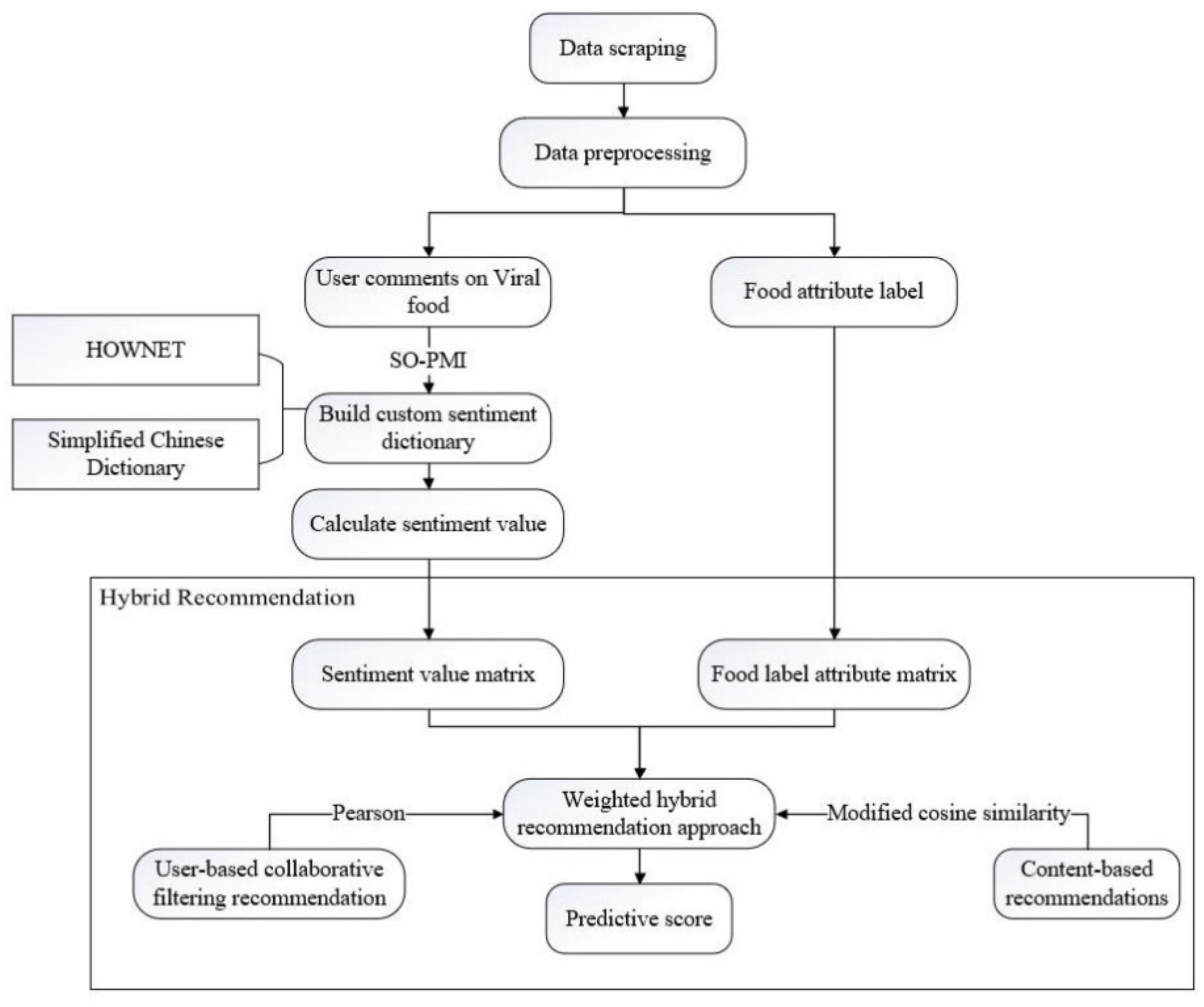
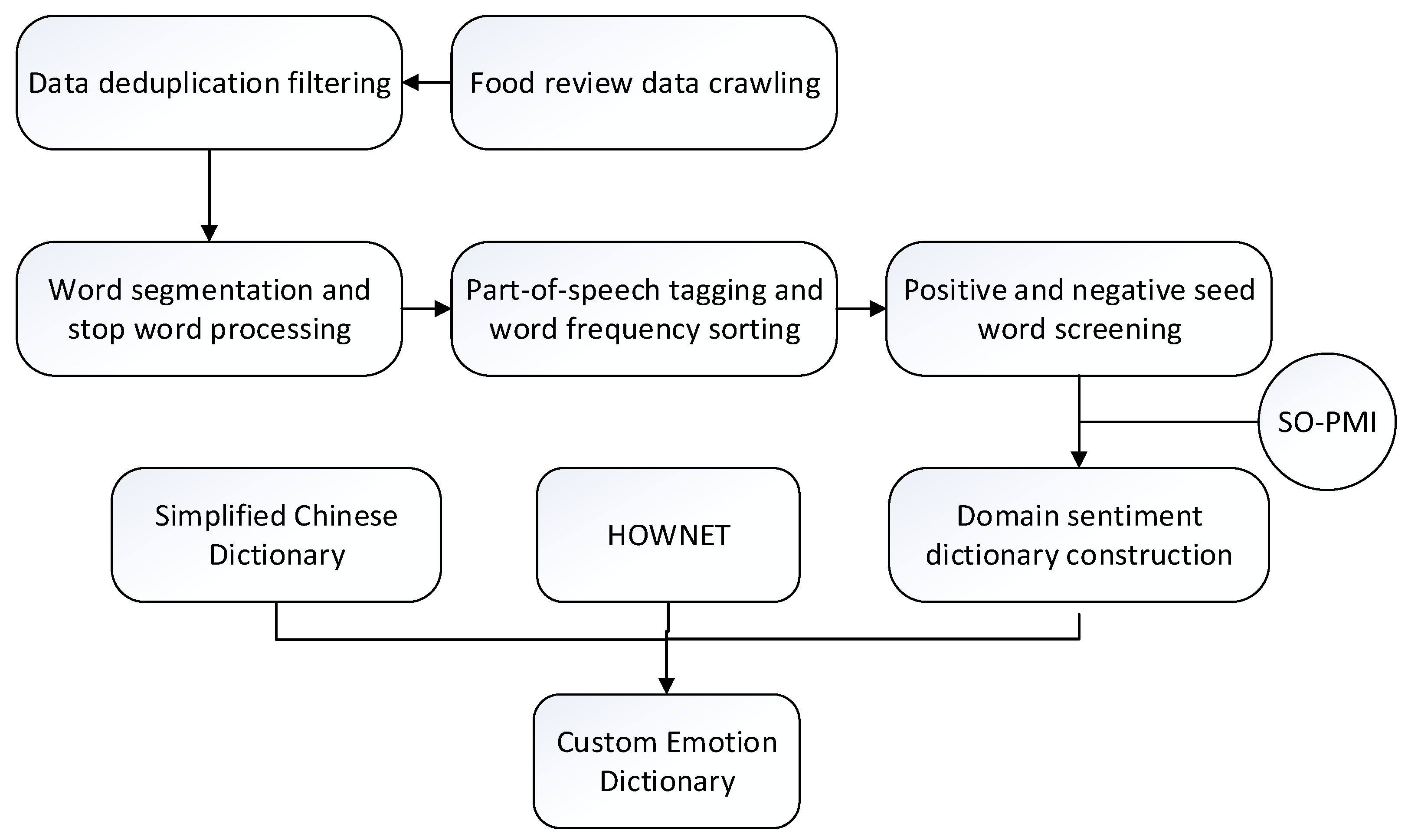
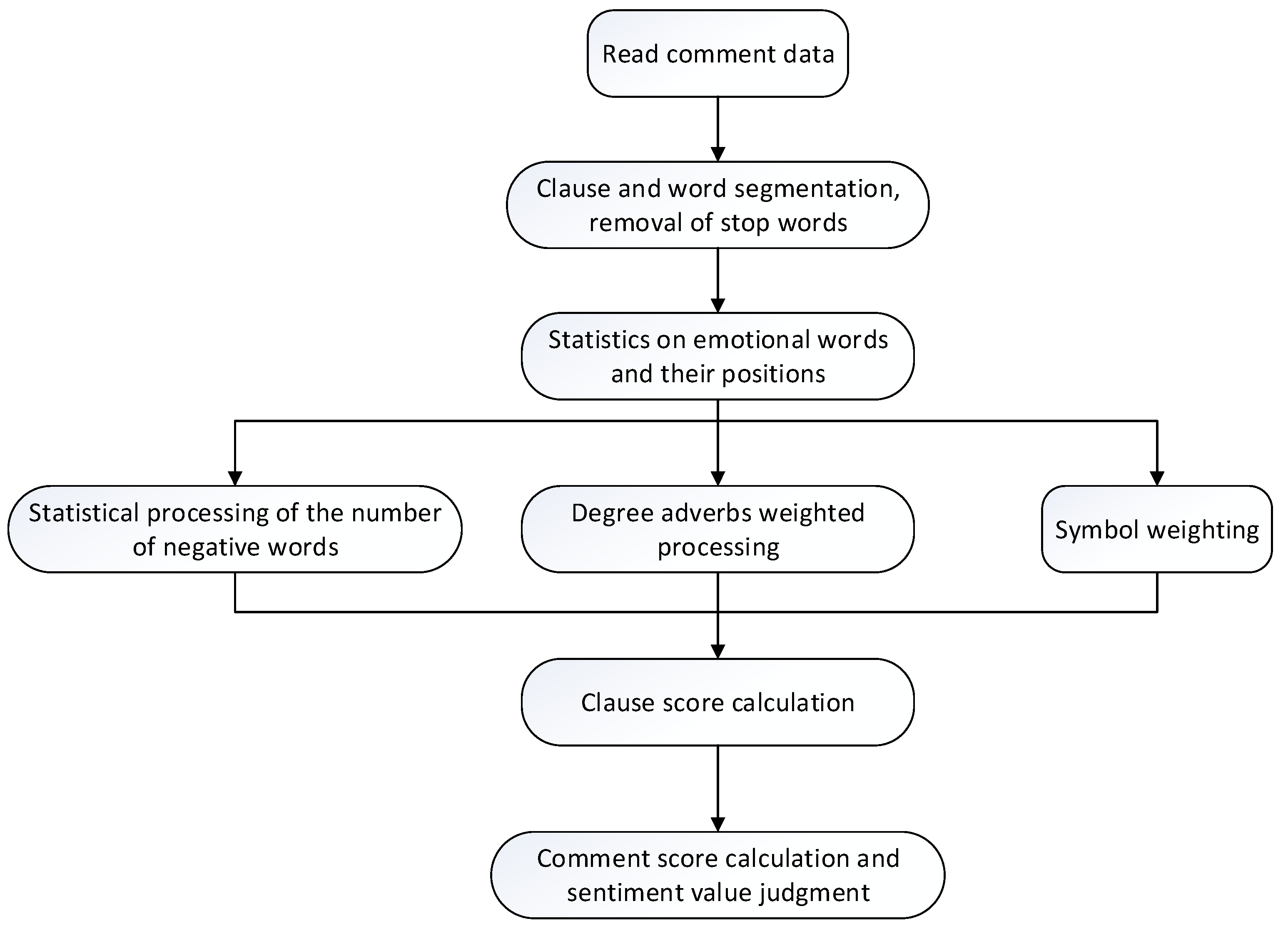
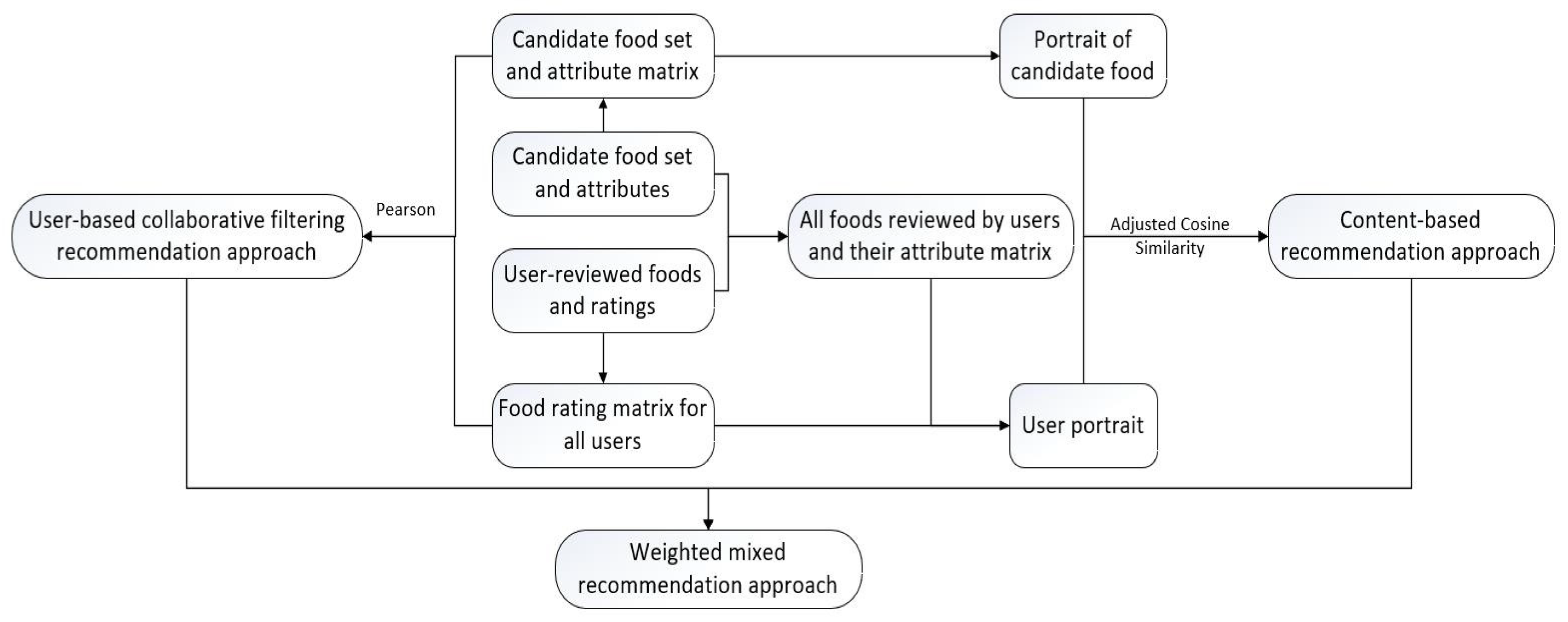
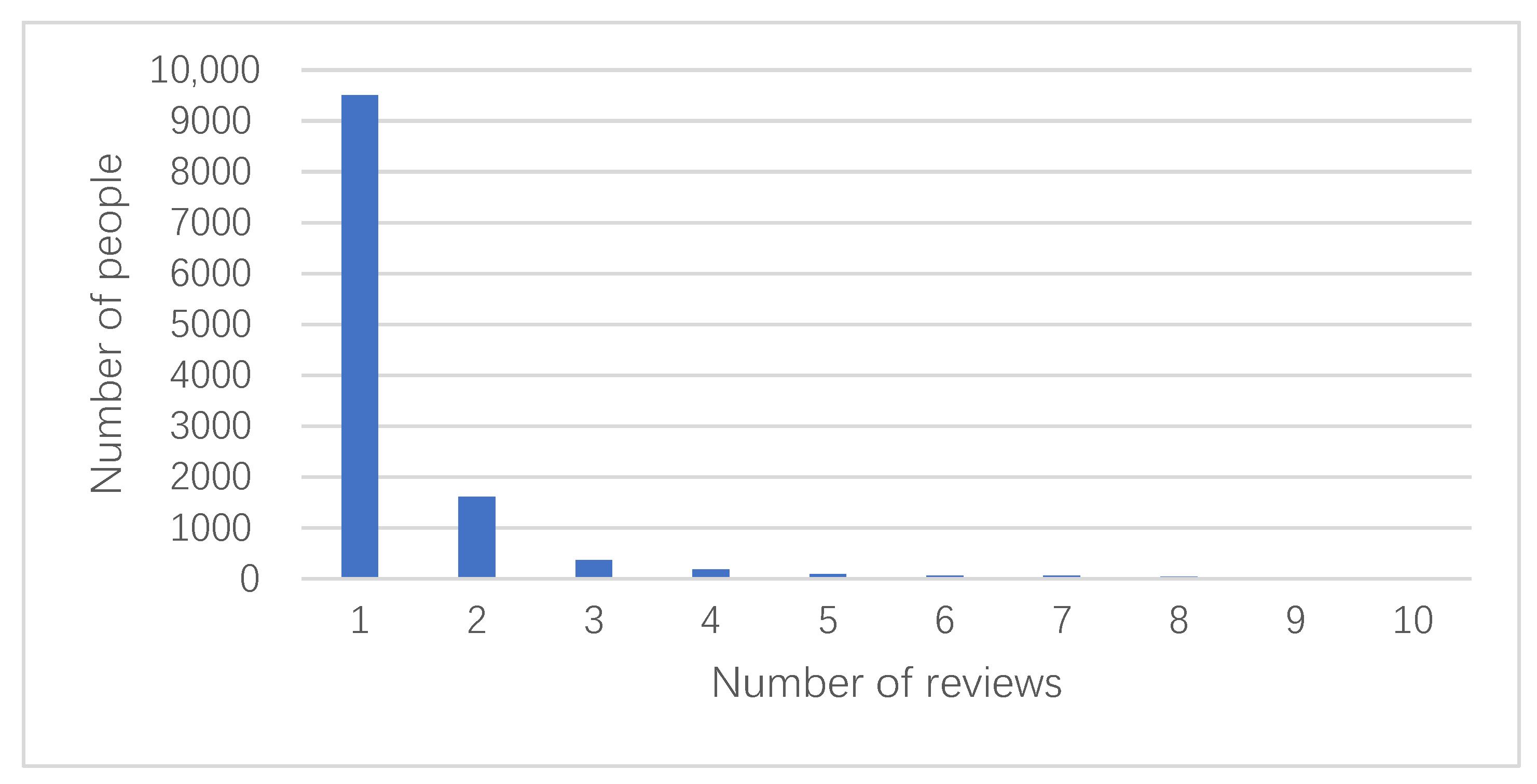
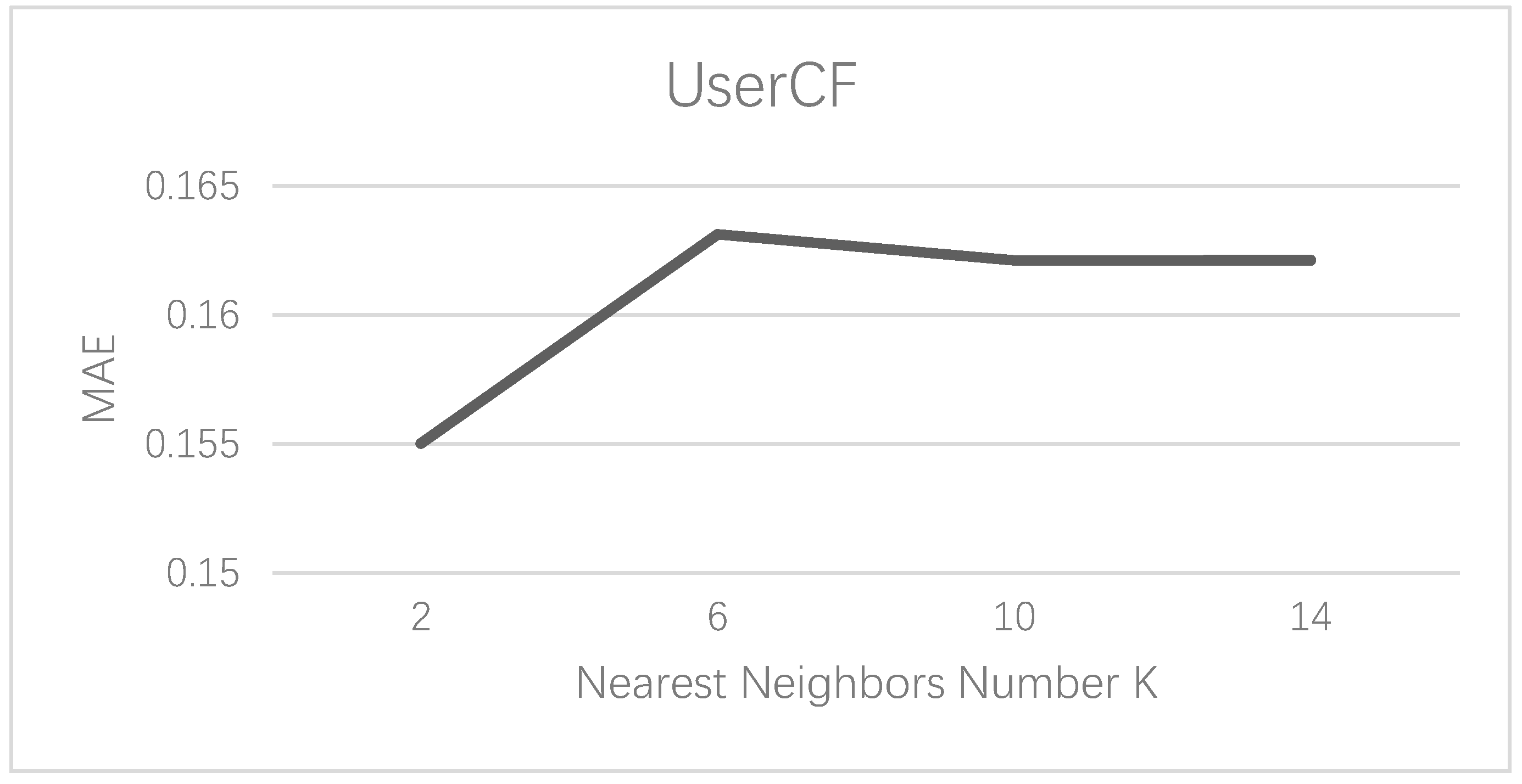
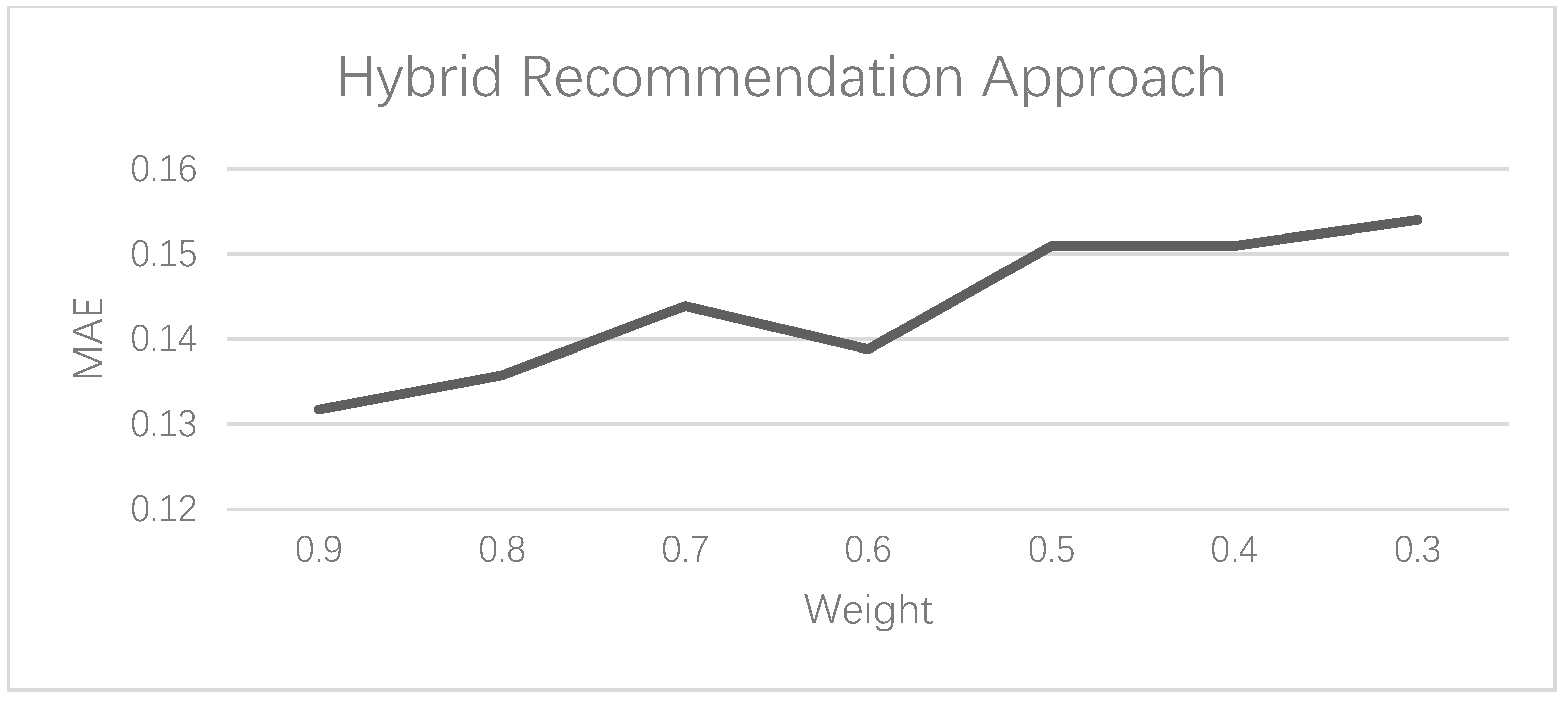
| HowNet | Simplified Chinese Dictionary | Custom Dictionary | |
|---|---|---|---|
| Precision | 93.96% | 94.45% | 94.52% |
| Recall | 92.80% | 82.60% | 96.40% |
| F1 | 93.38% | 87.89% | 95.33% |
| CB | UserCF | Hybrid | |
|---|---|---|---|
| MAE | 0.131712 | 0.155015 | 0.131704 |
| CB | UserCF | Hybrid | |
|---|---|---|---|
| Precision | 0.940867 | 0.927441 | 0.939712 |
| Recall | 0.893883 | 0.877653 | 0.895131 |
| F1 | 0.916773 | 0.90186 | 0.91688 |
| A | B | C | ||||
|---|---|---|---|---|---|---|
| True | Prediction | True | Prediction | True | Prediction | |
| Pine Cone Melaleuca Cookies Wafers | √ 1 | √ 2 | ||||
| Watermelon toast | √ 1 | √ 1 | ||||
| Barbecued Fish Tofu | ||||||
| Small Twist FCL | ||||||
| Mixed Candied Dried Fruit | ||||||
| Waffles with Milk Flavor | √ 1 | √ 1 | ||||
| Shredded beef jerky | ||||||
| Portuguese Salted Egg Yolk Crisp | √ 1 | √ 1 | √ 1 | √ 1 | ||
| Three Squirrels Golden Meat Muffins | √ 1 | √ 1 | ||||
| Lactic Acid Bacteria Bread | √ 1 | √ 1 | √ 1 | |||
| Pig’s Trotter Marinated Flavor | √ 1 | √ 1 | ||||
| Snow Crisp | √ 1 | √ 1 | √ 1 | √ 1 | ||
| Round Popping Mochi Dried Gnocchi | √ 1 | √ 2 | √ 1 | |||
| Sandwich waffle | √ 1 | √ 1 | √ 1 | |||
| Candy starry sky candy lollipop | ||||||
| Jelly Peach Flavor | ||||||
| Mimi Shrimp Crackers | √ 1 | √ 1 | √ 1 | |||
| Biscuit pastry snack | ||||||
| Cream puffs | ||||||
| Tiramisu Malt Cookies | √ 2 | √ 1 | ||||
| Gluten roll grilled gluten | √ 1 | |||||
| Spicy Beef Jerky | √ 1 | √ 1 | ||||
| Strawberry Marshmallow Fudge | √ 1 | √ 1 | √ 1 | |||
| Konjac silk konjac cool | ||||||
| Spicy Ezo Scallops | √ 1 | √ 1 | ||||
| Assorted Sandwich Cookies | ||||||
| Dried Pork | ||||||
| Sichuan peppercorns pepper flavor | √ 1 | √ 1 | ||||
| Tamarind, candied fruit, dried fruit | √ 1 | √ 1 | √ 1 | √ 1 | ||
| Sandwich Seaweed | √ 2 | √ 1 | ||||
| Strawberry Flavor Dumpling Mochi | √ 1 | √ 1 | √ 1 | √ 1 | ||
| Seedless milk jujube and almond | ||||||
| Strawberry Flavored Juice | √ 1 | √ 1 | √ 1 | √ 1 | ||
| Salted Egg Yolk Flavored Fish Skin | √ 1 | √ 1 | ||||
| Herbal Dried Mango | √ 1 | |||||
| Air Chocolate Raw Chocolate | √ 1 | √ 1 | √ 1 | √ 1 | ||
| Flower cake rose cake | √ 1 | √ 1 | √ 1 | |||
Publisher’s Note: MDPI stays neutral with regard to jurisdictional claims in published maps and institutional affiliations. |
© 2021 by the authors. Licensee MDPI, Basel, Switzerland. This article is an open access article distributed under the terms and conditions of the Creative Commons Attribution (CC BY) license (https://creativecommons.org/licenses/by/4.0/).
Share and Cite
Song, C.; Yu, Q.; Jose, E.; Zhuang, J.; Geng, H. A Hybrid Recommendation Approach for Viral Food Based on Online Reviews. Foods 2021, 10, 1801. https://doi.org/10.3390/foods10081801
Song C, Yu Q, Jose E, Zhuang J, Geng H. A Hybrid Recommendation Approach for Viral Food Based on Online Reviews. Foods. 2021; 10(8):1801. https://doi.org/10.3390/foods10081801
Chicago/Turabian StyleSong, Cen, Qing Yu, Esther Jose, Jun Zhuang, and He Geng. 2021. "A Hybrid Recommendation Approach for Viral Food Based on Online Reviews" Foods 10, no. 8: 1801. https://doi.org/10.3390/foods10081801
APA StyleSong, C., Yu, Q., Jose, E., Zhuang, J., & Geng, H. (2021). A Hybrid Recommendation Approach for Viral Food Based on Online Reviews. Foods, 10(8), 1801. https://doi.org/10.3390/foods10081801







